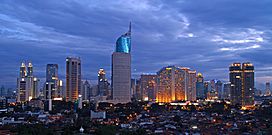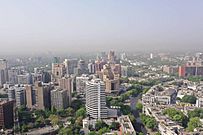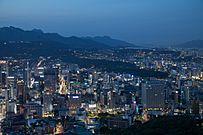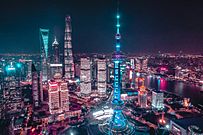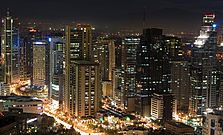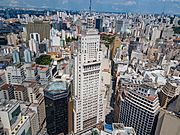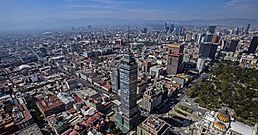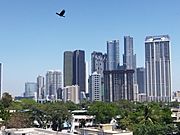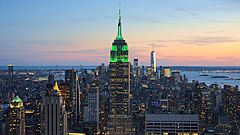List of largest cities facts for kids
Have you ever wondered what makes a place a "city"? It's not as simple as it sounds! The United Nations (UN) uses different ways to define a city because countries around the world don't all agree on what counts.
A city can be described in three main ways:
- Its official administrative boundaries (the "city proper").
- The area where buildings are continuously connected (the "urban area").
- A larger region that includes the city and its surrounding towns, where many people live and work (the "metropolitan area").
Contents
How We Define Cities
City Proper: Official Boundaries
A "city proper" is defined by its official, legal boundaries. Think of it like the specific area a city's government is in charge of. UNICEF explains it as "the population living within the administrative boundaries of a city or controlled directly from the city by a single authority." This definition often means the city has its own local government.
Sometimes, the "city proper" population might not include people living in the suburbs, even if they work or study in the city. For example, the Chinese city of Chongqing is huge! Its official area is about the size of Austria. But more than 70% of its 30 million people are actually farmers living in the countryside. This shows how different the "city proper" population can be from the "urban area" population.
Urban Area: Connected Buildings
An "urban area" is a place where buildings and development are continuously connected. It doesn't matter if there are different towns or cities inside this area; if it looks like one big built-up space, it's an urban area.
UNICEF notes that what counts as "urban" can change from country to country, and even over time. An urban area might be defined by:
- Its official boundaries.
- A certain number of people living there (usually at least 2,000, but it varies a lot).
- How many people live in a certain space (population density).
- The main jobs people do (if most people don't work in farming).
- Having city features like paved streets, electricity, or sewers.
Basically, an urban area is a large, connected space of buildings where people live and work, without much empty countryside in between.
Metropolitan Area: City and Its Commuters
A "metropolitan area" includes a main city and all the surrounding areas that are closely linked to it. This means places where people live but travel into the main city for work, school, or shopping.
UNICEF describes it as "a formal local government area comprising the urban area as a whole and its primary commuter areas." These areas are typically built around a large city, often with at least 100,000 people. They include both densely populated areas and some less dense areas connected by transport, roads, or people commuting.
Many countries use metropolitan areas for official statistics or planning. For example, in the United States, they have "metropolitan statistical areas" (MSAs). In the Philippines, the Metropolitan Manila Development Authority manages the Manila metropolitan area.
Largest Cities by Population
The United Nations estimated in 2018 that there are 81 cities worldwide with more than 5 million people. These figures combine different definitions like city proper, urban area, and metropolitan area.
| City | Country | UN 2018 population estimates | City proper | Urban area | Metropolitan area | |||||||
|---|---|---|---|---|---|---|---|---|---|---|---|---|
| Definition | Population | Area (km2) |
Density (/km2) |
Population | Area (km2) |
Density (/km2) |
Population | Area (km2) |
Density (/km2) |
|||
| Tokyo | 37,468,000 | Metropolis prefecture | 13,515,271 | 2,191 | 6,169 |
37,732,000 | 8,231 | 4,584 |
37,274,000 | 13,452 | 2,771 |
|
| Delhi | 28,514,000 | Municipal corporation | 16,753,235 | 1,484 | 11,289 |
32,226,000 | 2,344 | 13,748 |
29,000,000 | 3,483 | 8,326 |
|
| Shanghai | 25,582,000 | Municipality | 24,870,895 | 6,341 | 3,922 |
24,073,000 | 4,333 | 5,556 |
N/A | N/A | N/A | |
| São Paulo | 21,650,000 | Municipality | 12,252,023 | 1,521 | 8,055 |
23,086,000 | 3,649 | 6,327 |
21,734,682 | 7,947 | 2,735 |
|
| Mexico City | 21,581,000 | City-state | 9,209,944 | 1,485 | 6,202 |
21,804,000 | 2,530 | 8,618 | 21,804,515 | 7,866 | 2,772 |
|
| Cairo | 20,076,000 | Urban governorate | 10,044,894 | 3,085 | 3,256 |
20,296,000 | 2,010 | 10,098 | N/A | N/A | N/A | |
| Mumbai | 19,980,000 | Municipal corporation | 12,478,447 | 603 | 20,694 |
24,973,000 | 976 | 25,587 |
24,400,000 | 4,355 | 5,603 |
|
| Beijing | 19,618,000 | Municipality | 21,893,095 | 16,411 | 1,334 |
18,522,000 | 4,284 | 4,324 | N/A | N/A | N/A | |
| Dhaka | 19,578,000 | Capital city | 10,295,407 | 338 | 30,460 |
18,627,000 | 619 | 30,092 | 14,543,124 |
N/A | N/A | |
| Osaka | 19,281,000 | Designated city | 2,725,006 | 225 | 12,111 |
15,126,000 | 3,020 | 5,009 |
19,303,000 | 13,228 | 1,459 |
|
| New York City | 18,819,000 | City | 8,804,190 | 778 | 11,316 |
21,509,000 | 12,093 | 1,779 |
MSA: 19,557,311; CSA: 23,143,097 | 12,093 | 1,665 | |
| Karachi | 15,400,000 | Metropolitan city | 20,382,881 | 3,530 | 5,774 |
15,738,000 | 1,124 | 14,002 | 20,382,000 | 3,780 | 5,392 |
|
| Buenos Aires | 14,967,000 | Autonomous city | 3,054,300 | 203 | 15,046 |
16,710,000 | 3,437 | 4,862 | 12,806,866 |
N/A | N/A | |
| Chongqing | 14,838,000 | Municipality | 32,054,159 | 82,403 | 389 |
12,135,000 | 1,580 | 7,680 | N/A | N/A | N/A | |
| Istanbul | 14,751,000 | Metropolitan municipality | 15,519,267 | 5,196 | 2,987 |
14,441,000 | 1,471 | 9,817 | N/A | N/A | N/A | |
| Kolkata | 15,333,000 | Municipal corporation | 4,496,694 | 206 | 21,829 |
21,747,000 | 1,352 | 16,085 | 15,333,000 | 1,887 | 8,126 |
|
| Manila | 13,482,000 | Capital city | 1,780,148 | 43 | 41,399 |
24,922,000 | 1,911 | 13,041 |
12,877,253 | 620 | 20,770 |
|
| Lagos | 13,463,000 | Metropolitan city | N/A | N/A | N/A | 16,637,000 | 1,966 | 8,462 | 21,000,000 | 1,171 | 17,933 |
|
| Rio de Janeiro | 13,293,000 | Municipality | 6,520,000 | 1,221 | 5,340 |
12,592,000 | 2,020 | 6,234 | 12,644,321 | 5,327 | 2,374 |
|
| Tianjin | 13,215,000 | Municipality | 13,866,009 | 11,920 | 1,163 |
10,368,000 | 2,813 | 3,686 | N/A | N/A | N/A | |
| Kinshasa | 13,171,000 | City-province | 14,565,700 | 9,965 | 1,462 |
12,836,000 | 474 | 27,080 | N/A | N/A | N/A | |
| Guangzhou | 12,638,000 | City (sub-provincial) | 18,676,605 | 7,434 | 2,512 |
26,940,000 | 4,535 | 5,940 |
N/A | N/A | N/A | |
| Los Angeles | 12,458,000 | City | 3,990,456 | 1,214 | 3,287 |
15,204,000 | 6,351 | 2,394 | MSA: 13,291,486; CSA: 18,372,485 |
12,559 | 1,058 | |
| Moscow | 12,410,000 | Federal city | 13,200,000 | 2,511 | 5,257 |
17,332,000 | 6,154 | 2,816 | 20,004,462 |
N/A | N/A | |
| Shenzhen | 11,908,000 | City (sub-provincial) | 17,494,398 | 2,050 | 8,534 |
17,619,000 | 1,803 | 9,772 | N/A | N/A | N/A | |
| Lahore | 11,738,000 | Metropolitan city | 13,004,135 | 1,772 | 7,339 |
12,306,000 | 945 | 13,022 | N/A | N/A | N/A | |
| Bangalore | 11,440,000 | Municipal corporation | 8,443,675 | 709 | 11,909 |
15,386,000 | 1,401 | 10,982 | N/A | N/A | N/A | |
| Paris | 10,901,000 | Commune | 2,148,271 | 105 | 20,460 |
11,060,000 | 2,853 | 3,877 | 12,244,807 | 18,941 | 646 | |
| Bogotá | 10,574,000 | Capital District | 7,963,000 | 1,587 | 5,018 |
10,085,000 | 562 | 17,945 | 12,545,272 | 5,934 | 2,114 |
|
| Jakarta | 10,517,000 | Special capital region | 10,154,134 | 664 | 15,292 |
33,756,000 | 3,546 | 9,519 |
33,430,285 | 7,063 | 4,733 |
|
| Chennai | 10,456,000 | Municipal corporation | 6,727,000 | 426 | 15,791 |
12,395,000 | 1,085 | 11,424 | 11,564,000 | 2,280 | 5,072 |
|
| Lima | 10,391,000 | Metropolitan municipality | 8,894,000 | 2,672 | 3,329 |
10,320,000 | 891 | 11,582 | 9,569,468 | 2,819 | 3,395 |
|
| Bangkok | 10,156,000 | Special administrative area | 8,305,218 | 1,569 | 5,293 |
18,007,000 | 3,199 | 5,629 | 16,255,900 | 7,762 | 2,094 |
|
| Seoul | 9,963,000 | Special city | 10,013,781 | 605 | 16,552 |
23,016,000 | 2,769 | 8,312 | 25,514,000 | 11,704 | 2,180 |
|
| Nagoya | 9,507,000 | Designated city | 2,320,361 | 326 | 7,118 |
9,197,000 | 3,704 | 2,483 | 9,363,000 | 7,271 | 1,288 |
|
| Hyderabad | 9,482,000 | Municipal corporation | 6,993,262 | 650 | 10,759 |
10,494,000 | 1,404 | 7,474 | N/A | N/A | N/A | |
| London | 9,046,000 | Capital city | 8,825,001 | 1,572 | 5,614 |
11,262,000 | 1,738 | 6,480 | 14,372,596 |
8,382 | 1,715 | |
| Tehran | 8,896,000 | Capital city | 9,033,003 | 751 | 12,028 |
14,148,000 | 1,704 | 8,303 | N/A | N/A | N/A | |
| Chicago | 8,864,000 | City | 2,746,388 | 589 | 4,663 |
9,057,000 | 7,006 | 1,293 | MSA: 9,618,502; CSA: 9,806,184 |
18,640 | 516 | |
| Chengdu | 8,813,000 | City (sub-provincial) | 20,937,757 | 14,378 | 1,456 |
20,937,757 | 1,935 | 10,821 | N/A | N/A | N/A | |
| Nanjing | 8,245,000 | City (sub-provincial) | 9,314,685 | 6,582 | 1,415 |
8,422,000 | 1,614 | 5,218 | N/A | N/A | N/A | |
| Wuhan | 8,176,000 | City (sub-provincial) | 12,447,718 | 8,494 | 1,465 |
12,447,718 | 1,722 | 7,229 | N/A | N/A | N/A | |
| Ho Chi Minh City | 8,145,000 | Municipality | 7,431,000 | 2,061 | 3,606 |
15,136,000 | 2,165 | 6,991 | N/A | N/A | N/A | |
| Luanda | 7,774,000 | Municipality | 2,165,867 | 116 | 18,671 |
9,051,000 | 1,005 | 9,006 | N/A | N/A | N/A | |
| Ahmedabad | 7,681,000 | Municipal corporation | 5,570,585 | 464 | 12,006 |
8,009,000 | 404 | 19,824 | 6,300,000 |
N/A | N/A | |
| Kuala Lumpur | 7,564,000 | City | 1,768,000 | 243 | 7,276 |
8,911,000 | 2,163 | 4,120 | 7,200,000 | 2,793 | 2,578 |
|
| Xi'an | 7,444,000 | City (sub-provincial) | 12,183,280 | 10,135 | 1,202 |
12,328,000 | 1,826 | 6,751 | N/A | N/A | N/A | |
| Hong Kong | 7,429,000 | Special administrative region | 7,298,600 | 1,104 | 6,611 |
7,450,000 | 290 | 25,690 | N/A | N/A | N/A | |
| Dongguan | 7,360,000 | Prefecture-level city | 10,466,625 | 2,465 | 4,246 |
10,646,000 | 1,759 | 6,052 | N/A | N/A | N/A | |
| Hangzhou | 7,236,000 | City (sub-provincial) | 11,936,010 | 16,596 | 719 |
9,523,000 | 1,344 | 7,086 | N/A | N/A | N/A | |
| Foshan | 7,236,000 | Prefecture-level city | 9,498,863 | 3,848 | 2,469 |
N/A |
N/A | N/A | N/A | N/A | N/A | |
| Shenyang | 6,921,000 | City (sub-provincial) | 8,294,000 | 12,980 | 639 |
7,964,000 | 1,551 | 5,135 |
N/A | N/A | N/A | |
| Riyadh | 6,907,000 | Municipality | 6,694,000 | 1,913 | 3,499 |
7,237,000 | 1,673 | 4,326 | N/A | N/A | N/A | |
| Baghdad | 6,812,000 | Urban governorate | 8,126,755 | 5,200 | 1,563 |
6,183,000 | 694 | 8,909 | N/A | N/A | N/A | |
| Santiago | 6,680,000 | City (commune) | 236,453 | 22 | 10,748 |
7,171,000 | 1,147 | 6,252 | 7,112,808 | 15,403 | 462 |
|
| Surat | 6,564,000 | Municipal corporation | 4,466,826 | 327 | 13,660 |
6,538,000 | 238 | 27,471 | N/A | N/A | N/A | |
| Madrid | 6,497,000 | Municipality | 3,266,126 | 606 | 5,390 |
6,211,000 | 1,365 | 4,550 | 6,641,649 | N/A | N/A | |
| Suzhou | 6,339,000 | Prefecture-level city | 12,748,262 | 8,488 | 1,502 |
6,031,000 | 1,386 | 4,351 | N/A | N/A | N/A | |
| Pune | 6,276,000 | Municipal corporation | 3,124,458 | 276 | 11,321 |
8,231,000 | 650 | 12,663 | 7,276,000 | 7,256 | 1,003 |
|
| Harbin | 6,115,000 | City (sub-provincial) | 10,635,971 | 53,068 | 200 |
3,830,000 | 671 | 5,708 | N/A | N/A | N/A | |
| Houston | 6,115,000 | City | 2,325,502 | 1,553 | 1,497 |
6,500,000 | 4,931 | 1,318 | 6,997,384 | 21,395 | 327 |
|
| Dallas | 6,099,000 | City | 1,345,047 | 882 | 1,525 |
6,950,000 | 5,278 | 1,317 |
7,470,158 | 22,463 | 333 |
|
| Toronto | 6,082,000 | City | 2,731,571 | 630 | 4,336 |
6,771,000 | 2,344 | 2,889 | 5,928,040 | 5,906 | 1,004 |
|
| Dar es Salaam | 6,048,000 | City | 5,383,728 | 1,393 | 3,865 |
7,962,000 | 961 | 8,285 | N/A | N/A | N/A | |
| Miami | 6,036,000 | City | 470,914 | 93 | 5,069 |
6,058,000 | 3,313 | 1,829 | 6,158,824 | 15,890 | 388 | |
| Belo Horizonte | 5,972,000 | City | 2,502,557 | 331 | 7,563 | 5,328,000 | 1,287 | 4,140 | 5,156,217 | 9,459 | 545 | |
| Singapore | 5,792,000 | Country | 5,638,700 | 726 | 7,770 | 5,983,000 | 523 | 11,440 | N/A | N/A | N/A | |
| Philadelphia | 5,695,000 | Consolidated city-county | 1,526,006 | 370 | 4,129 | 5,799,000 | 5,429 | 1,068 | MSA: 6,096,120; CSA: 7,381,187 | N/A | N/A | |
| Atlanta | 5,572,000 | City | 498,715 | 354 | 1,408 | 5,478,000 | 7,400 | 740 | 5,949,951 | 21,690 | 274 | |
| Fukuoka | 5,551,000 | Designated city | 1,588,924 | 343 | 4,627 | 2,286,000 | 505 | 4,527 | N/A | N/A | N/A | |
| Khartoum | 5,534,000 | N/A | 1,410,858 |
N/A | N/A | 7,869,000 | 1,031 | 7,632 | N/A | N/A | N/A | |
| Barcelona | 5,494,000 | Municipality | 1,620,343 | 101 | 15,980 |
4,800,000 | 1,072 | 4,478 | 5,474,482 |
N/A | N/A | |
| Johannesburg | 5,486,000 | Metropolitan municipality | 4,803,262 | 1,643 | 2,924 | 14,586,000 | 4,040 | 3,610 |
N/A | N/A | N/A | |
| Saint Petersburg | 5,383,000 | Federal city | 5,601,911 | 1,400 | 4,001 | 5,445,000 | 1,510 | 3,606 | N/A | N/A | N/A | |
| Qingdao | 5,381,000 | City (sub-provincial) | 10,071,722 | 11,229 | 897 | 6,229,000 | 1,759 | 3,541 | N/A | N/A | N/A | |
| Dalian | 5,300,000 | City (sub-provincial) | 7,450,785 | 13,742 | 542 | 4,135,000 | 1,044 | 3,961 | N/A | N/A | N/A | |
| Washington | 5,207,000 | Federal district | 702,455 | 177 | 3,969 |
7,631,000 | 5,501 | 1,387 |
6,263,245 | 17,009 | 368 |
|
| Yangon | 5,157,000 | City | 4,728,524 | N/A | N/A | 6,874,000 | 666 | 10,321 | N/A | N/A | N/A | |
| Alexandria | 5,086,000 | Urban governorate | 5,441,866 | 2,300 | 2,366 | 4,712,000 | 293 | 16,082 | N/A | N/A | N/A | |
| Jinan | 5,052,000 | City (sub-provincial) | 9,202,432 | 10,244 | 898 |
4,017,000 | 932 | 4,310 | N/A | N/A | N/A | |
| Guadalajara | 5,023,000 | Municipality | 1,385,621 | 151 | 9,176 |
5,525,000 | 816 | 6,771 | 5,286,642 | 3,560 | 1,485 | |
Gallery
-
Tokyo, Japan: 39.1 million people (urban area)
-
Jakarta, Indonesia: 34.5 million people (urban area)
-
Delhi, India: 32.2 million people (urban area)
-
Seoul, South Korea: 26 million people (metropolitan area)
-
Shanghai, China: 24.8 million people (municipal area)
-
Manila, Philippines: 24.1 million people (urban area)
-
São Paulo, Brazil: 22 million people (metropolitan area)
-
Beijing, China: 21.9 million people (municipal area)
-
Mexico City, Mexico: 21.8 million people (metropolitan area)
-
Mumbai, India: 20.7 million people (metropolitan area)
-
New York City, U.S.: 19.4 million people (urban area)
See also
- Historical urban community sizes
- List of largest cities throughout history
- List of cities with a million or more inhabitants
- List of towns and cities with 100,000 or more inhabitants
- List of largest cities by area




